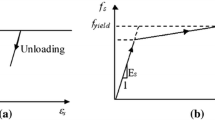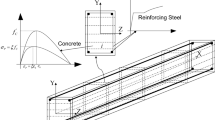Abstract
Inclined cracks that take place in reinforced concrete elements due to tangential internal forces, such as shear and torsion, produce a non-isotropic response on the structure in the post-cracked regime and up to failure, also known as crack-induced-anisotropy. The result is that all six internal forces acting in a cross-section are generally coupled.
A generalized beam formulation for the nonlinear coupled analysis of non-isotropic elements under six internal forces is presented. The theory is based on a cross-section analysis approach with both warping and distortion capabilities, which were proved necessary to correctly handle the problem with frame element analysis.
In this paper, the non-linear mechanical aspects of cracked concrete structures under tangential forces are summarized. A state of the art review of beam formulations for the non-linear analysis of concrete structures is presented, and the approaches followed to account for the interaction of shear and torsion forces are discussed. After presenting the proposed formulation, its capabilities are shown by means of an application example of a cross section under coupled bending-shear and torsion, finally main conclusions are drawn.
Similar content being viewed by others
References
Abbas S, Scordelis AC (1993) Nonlinear geometric, material and time-dependent analysis of segmentally erected three-dimensional cable stay bridges. Report UCB/SEMM-93/09, University of California, Berkeley
ASCE-ACI Committee 445 (1998) Recent approaches to shear design of structural concrete. ASCE J Struct Eng 124(12):1375–1417
Auricchio F, Sacco E (1999) Partial-mixed formulation and refined models for the analysis of composite laminates within a FSDT. Compos Struct 46:103–113
Auricchio F, Sacco E (2003) Refined first-order shear deformation theory models for composite laminates. ASME J Appl Mech 70:381–390
Bairan JM, Mari AR (2006) Coupled model for the nonlinear analysis of anisotropic sections subjected to general 3D loading. Part 1: theoretical formulation. Comput Struct 84(31–32):2254–2263
Bairan JM, Mari AR (2006) Coupled model for the nonlinear analysis of anisotropic sections subjected to general 3D loading. Part 2: implementation and validation. Comput Struct 84(31–32):2264–2276
Bairan JM, Mari AR (2007) Multiaxial-coupled analysis of RC cross-sections subjected to combined forces. Eng Struct 29(8):1722–1738
Bažant ZP, Oh BH (1983) Crack band theory for fracture of concrete. Mat Struct 16(93):155–177
Bažant ZP, Prat PC (1988) Microplane model for brittle-plastic material: I. Theory. ASCE J Eng Mech 114(10):1672–1688
Backlund J (1976) Large deflection analysis of elasto-plastic beams and frames. Int J Mech Sci 18:269–277
Barbero EJ (1992) 3-D finite element for laminated composites with 2-D kinematics constraints. Comput Struct 45:263–271
Barbero EJ (1998) Introduction to composite materials design. Taylor & Francis, London, pp 336
Baron F (1961) Matrix analysis of structures curved in space. ASCE J Struct Div 87:17–38
Bentz E (2000) Sectional analysis of reinforced concrete members. Doctoral thesis, University of Toronto, Toronto, pp 184
Buckle IG, Jackson AT (1981) A filamented beam element for the nonlinear analysis of reinforced concrete shells with edge beams. University of Auckland, New Zealand
Carol I, Murcia J (1989) Nonlinear time-dependent analysis of planar frames using and exact formulation—I theory. Comput Struct 33(1):79–87
Carol I, Bažant ZP, Prat PC (1990) New explicit microplane model for concrete: theoretical aspects and unified implementation for constitutive verification and F.E. Analysis. Report No GT015/1990, School of Civil Eng, Technical University of Catalonia, Barcelona, pp 29
Carrascon S, Mari AR, Carol I (1987) Analisis instantáneo y diferido de puentes curvos de hormigón armado y pretensado. Publication ES-015, Depart of Construction Eng, Technical University of Catalonia, Barcelona
Carrera E (1999) Multilayered shell theories accounting for a layer-wise mixed description. Part I: governing equations. AIAA J 37:1117–1124
CEB (1996) RC elements under cyclic loading: state of the art report. Comité Euro-International du Béton, Bulletin d’indormation 230, Thomas Telford, London, pp 190
Cesnick CES, Hodges DH (1994) Variational-asymptotical analysis of initially twisted and curved composite beams. Int J Eng Anal Des 1(2):177–187
Chan EC-Y (1983) Nonlinear geometric, material and time dependent analysis of reinforced concrete shells with edge beams. Doctoral thesis, University of California, Berkeley, pp 361
Chen WF (1982) Plasticity in reinforced concrete. McGraw-Hill, New York, pp 474
Cobo D, Burgueño R, Seible F, Marí AR (2000) Use of advanced composite materials in the design of a cable stay bridge. Hormigón y Acero, No 216, 2nd trimester, Spain
Cruz PJS, Marí AR, Roca P (1998) Nonlinear time-dependent analysis of segmentally constructed structures. ASCE J Struct Eng 124(3):278–287
Elwi AA, Murray DW (1979) A 3D hypoelastic concrete constitutive relationship. ASCE J Eng Mech Div 105(4):623–641
Fam A, Musiker D, Kowalsky MJ, Rizkalla S (2002) In-plane testing of a damaged masonry wall repaired with FRP, Adv Compos Lett 11(6)
Ghali A, Elbadry MM (1985) User’s manual and computer program CPF: cracked plane frames in prestressed concrete. Research Report CE 85-2, Department of Civil Engineering, The University of Calgary, Calgary
Grelat A (1978) Comportament non linéaire et stabilité des ossatures en béton armé. Ann Inst Tech Batiment Trav Publics 111(1):19–36
Hsu TT (1984) Torsion of reinforced concrete. Van Nostrand Reinhold, New York, pp 515
Jefferson A (2000) Anisotropic damage model derived from random fibre network. In: European congress on computational methods in applied sciences and engineering, ECCOMAS 2000, Barcelona
Kang YI, Scordelis AC (1980) Nonlinear analysis of prestressed concrete frames. ASCE J Struct Div 106:445–462
Kang YI, Scordelis AC (1990) Non-linear segmental analysis of reinforced and prestressed concrete bridges. In: 3rd international conference on short and medium span bridges, Toronto, pp 229–240
Ketchum MA (1986) Redistribution of stresses in segmentally erected prestressed concrete bridges. Report UCB-SESM 86/07, University of California, Berkeley
Lampert P (1972) Postcracking stiffness of reinforced concrete beams in torsion and bending. Analysis of structural systems for torsion. ACI Publication SP-35, American Concrete Institute, Detroit, pp 384–432
Lopez A (1987) Estudio de la evolución hasta la rotura de tableros continuos de puentes de hormigón pretensado de planta curva o esviada. Doctoral thesis, Technical University of Catalonia, Barcelona
Luccioni B, Oller S (2003) A directional damage model. Comput Methods Appl Mech Eng 1119–1145
Mari AR (1984) Nonlinear geometric, material and time dependent analysis of three-dimensional reinforced and prestressed concrete frames. Report No UCB/SESM-84/12, University of California, Berkeley, pp 142
Mari AR (2000) Numerical simulation of the segmental construction of three dimensional concrete frames. Eng Struct 22(6):585–596
Mazars J (1982) Mechanical damage and fracture of concrete structures. In: Advances in fracture research, vol 4, Pergamon, Oxford, pp 1499–1506
Mitchell D, Collins MP (1974) Diagonal compression field theory—a rational model for structural concrete in pure torsion. J Am Concr Inst 71:396–408
Molins C, Roca P, Barbat AH (1995) Una formulacion matricial generalizada. Parte 2: análisis dinámico. Rev Int Métodos Num calc diseñ Ing 11(1):23–36
Molins C, Roca P, Mari AR (1995) One dimensional elements for the static and dynamic analysis of historic spatial structures. In: Spatial structures: heritage, present and future. SGEditorial, Padua, pp 1245–1252
Murcia J, Herkenhoffm L (1994) Time dependent analysis of continuous bridges composed by precast elements. Hormigón y Acero, vol 192, pp 55–71
Nettles AT (1994) Basic mechanics of laminated composite plates. NASA Reference Publication 1351, Marshall Space Flight Center, Alabama, pp 102
Oller E, Cobo D, Mari AR (2004) Flexural srengthening of RC beams using composite materials. End anchorage study, Hormigón y Acero, No 232, 2nd trimester, Spain
Oller S (ed) (2002) Analisis y calculo de estructuras de materiales compuestos. Cimne, Barcelona, pp 576
Onsongo WM (1978) The diagonal compression field theory for reinforced concrete beams subjected to combined torsion, flexure and axial load. Doctoral thesis, University of Toronto, Toronto, pp 246
Park R, Paulay T (1994) Estructuras de concrete reforzado. Limusa, Mexico, pp 796
Petrangeli M, Pinto PE, Ciampi V (1999) Fiber element for cyclic bending and shear of RC structures. I: theory. ASCE J Eng Mech 125(9):994–1009
Priestley MJN, Seible F, Calvi GM (1996) Seismic design and retrofit of bridges. Wiley, New York
Rahal KN, Collins MP (2003) Combined torsion and bending in reinforced and prestressed concrete beams. ACI Struct J 100(2):157–165
Rahal KN, Collins MP (1994) Analysis of sections subjected to combined shear and torsion—a theoretical model. ACI Struct J 92(4):459–469
Ranzo G (2000) Experimental and numerical studies on the seismic performance of beam-column RC structural members subjected to high shear. Doctoral thesis, University of Rome “La Sapienza”, Rome, pp 238
Recupero A, D’Aveni A, Ghersi A (2003) N-M-V interaction domains for box and I-shaped reinforced concrete members. ASCE J Struct Eng 100(1):113–119
Recupero A, D’Aveni A, Ghersi A (2005) Bending moment-shear force interaction domains for prestessed concrete beams. ASCE J Struct Eng 131(9):1413–1421
Reddy JN (1996) Mechanics of laminated composite plates. CRC Press, Boca Raton, pp 800
Reddy JN (1997) On locking-free shear deformable beam finite elements. Comput Methods Appl Mech Eng 149:113–132
Saouridis C, Mazars J (1992) Prediction of the failure ans size effect in concrete via a bi-scale damage approach. Eng Comput 9:329–344
Simo JC, Ju JW, Pister KS, Taylor RL (1988) Assesment of cap model: consistent return algorithms and rate-dependent extension. ASCE J Eng Mech 114:191–218
Sobrino JA, Pulido MDG (2002) Towards advanced composite material footbridges. In: Structural eng international, SEI 2/2002, May, 2002
Spacone E, Ciampi V, Filippou FC (1996) Mixed formulation of no nlinear beam finite element. Comput Struct 58(1):71–83
Timoshenko ST, Goodier JN (1972) Teoria de la elasticidad (Theory of elasticity). Urmo, Bilbao, pp 549
Ulm FJ, Clement JL, Guggenberger J (1994) Recent advances in 3-D nonlinear FE-analysis or R/C and P/C beam structures. In: Proc ASCE Structures Congress XII, Atlanta (GA), New York, pp 427–1433
Vecchio FJ, Collins MP (1988) Predicting the response of reinforced concrete beams subjected to shear using the modified compression field theory. ACI Struct J 85(3):258–268
Yu W, Volovoi V, Hodges D, Hong X (2002) Validation of the variational asymptotic beam sectional analysis (VABS). AIAA J 40(10):2105–2113
Author information
Authors and Affiliations
Corresponding author
Rights and permissions
About this article
Cite this article
Bairan Garcia, J.M., Mari Bernat, A.R. Shear-Bending-Torsion Interaction in Structural Concrete Members: A Nonlinear Coupled Sectional Approach. Arch Computat Methods Eng 14, 249–278 (2007). https://doi.org/10.1007/s11831-007-9007-5
Published:
Issue Date:
DOI: https://doi.org/10.1007/s11831-007-9007-5




